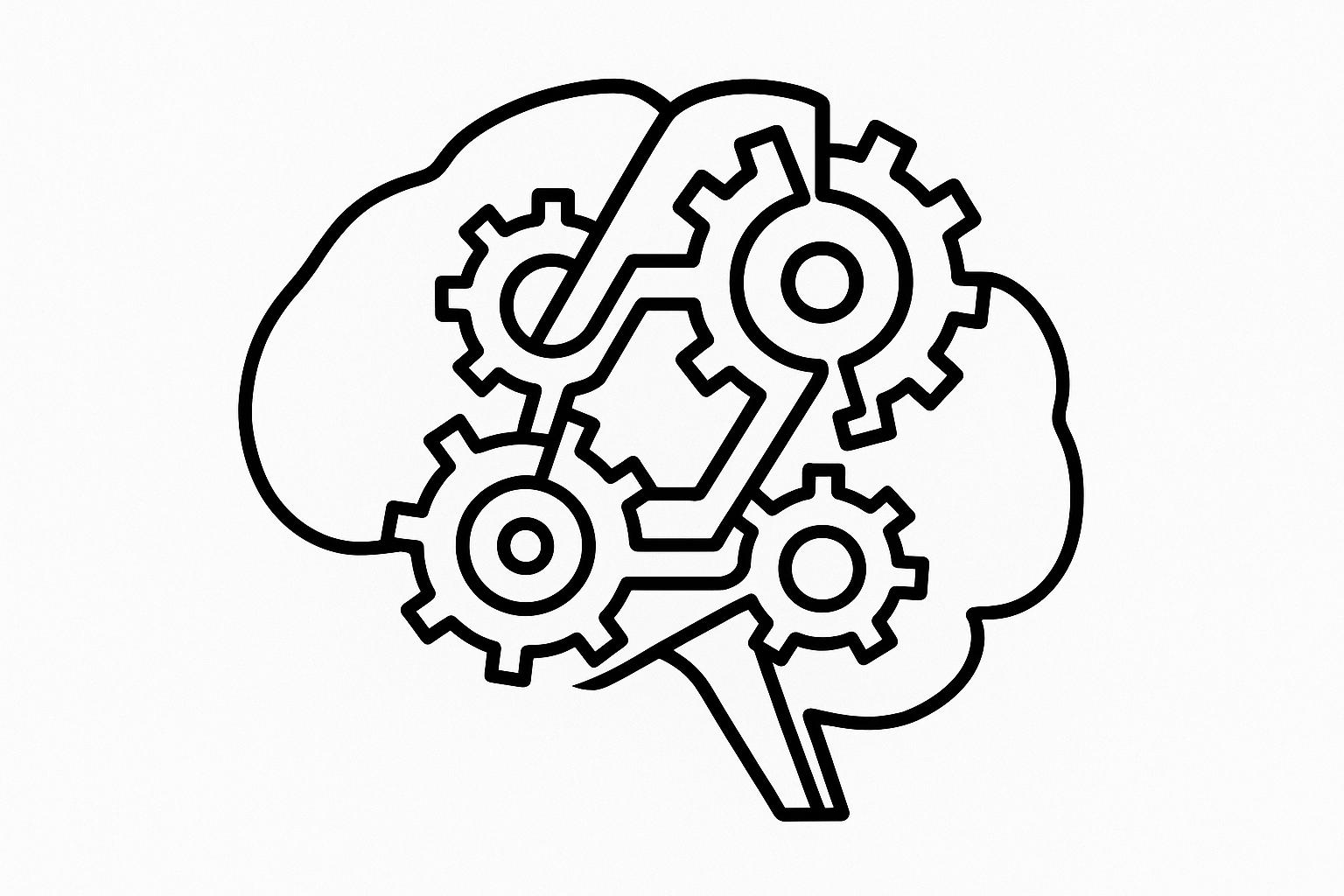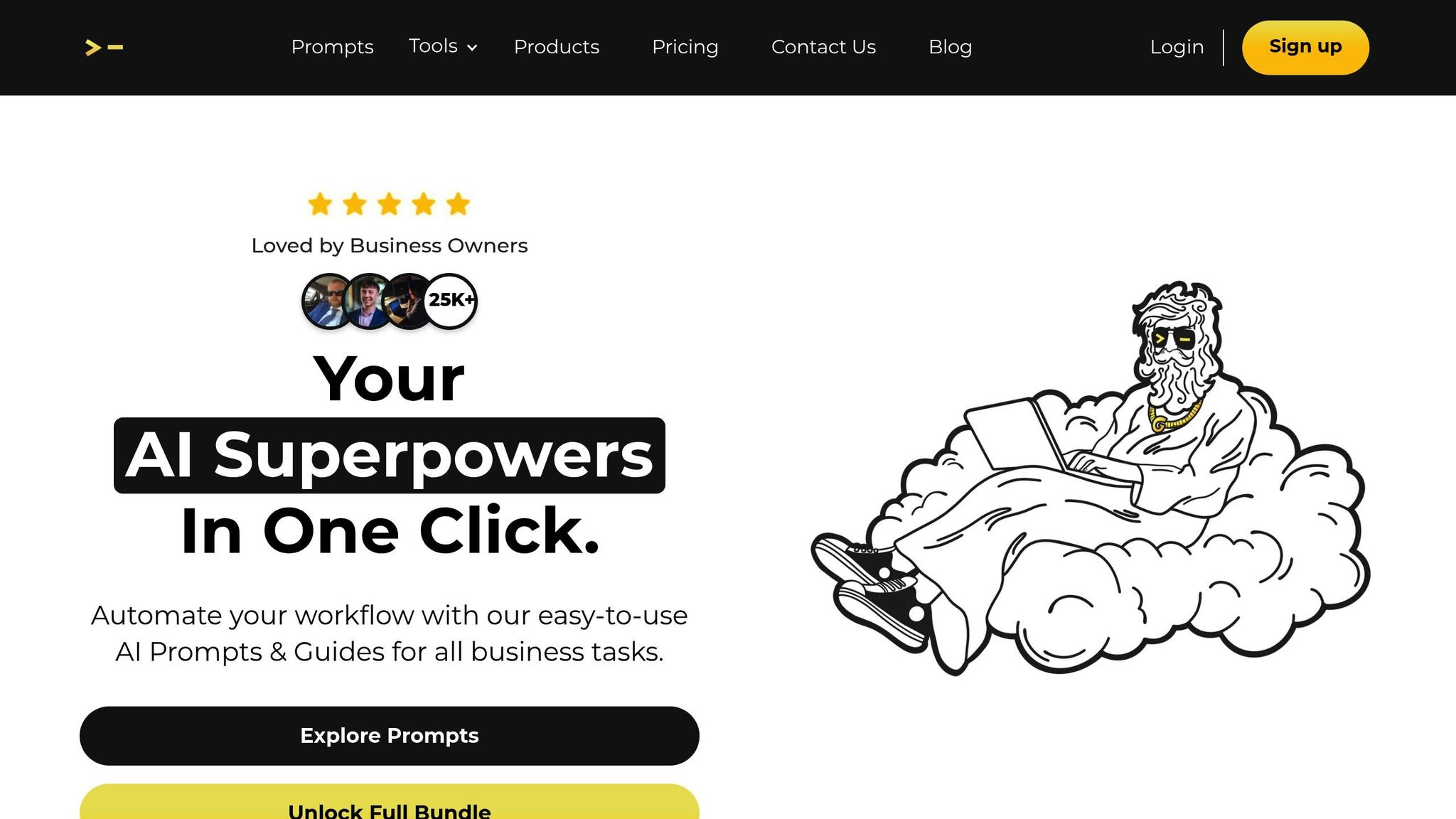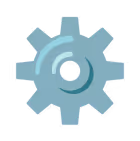
AI is transforming how teams share and access information. Traditional methods like email chains and scattered documents slow productivity. AI-powered tools streamline this by organizing, retrieving, and distributing knowledge efficiently. Here's how:
AI tools like "God of Prompt" standardize workflows with pre-built prompts, ensuring consistent results. Implementing AI systems requires consolidating data, automating knowledge flow, and prioritizing security. Regular updates and analytics help refine these systems over time, ensuring teams stay productive and informed.
AI-powered knowledge management systems are transforming how teams access, share, and grow their knowledge. By speeding up access to information and personalizing insights, these tools are helping teams work smarter and more efficiently.
One of the standout advantages of AI-powered systems is how much time they save when it comes to finding information. In traditional setups, employees often waste valuable hours digging through files, databases, or endless email threads just to locate a single piece of information. AI changes the game by understanding natural language queries and delivering precise answers almost instantly.
Imagine asking the system a question in plain language and receiving not just a document but a concise summary of the key points you need. That’s the power of AI - it doesn’t just retrieve data; it makes it usable.
This speed has a ripple effect: faster decision-making, shorter project timelines, and the ability to pivot quickly when circumstances change. On top of that, AI ensures that the information provided is relevant to the person asking, making it not just quick but also highly effective.
AI systems shine when it comes to tailoring information to individual needs. Instead of bombarding users with a flood of generic data, these platforms learn from each person’s role, current projects, and past interactions to deliver content that’s genuinely useful.
For example, a project manager might receive updates on timelines and resources, while a developer gets access to technical documentation specific to their tasks. This kind of personalization ensures that everyone gets the right information at the right time.
But it doesn’t stop there. AI also identifies gaps in knowledge and suggests ways to fill them. If someone frequently searches for a particular topic, the system might recommend training materials, connect them with an expert, or even suggest projects that could deepen their understanding. It’s a proactive approach to learning that helps employees grow as they work.
AI also adapts to the needs of global teams. For instance, remote team members in different time zones can stay in the loop with asynchronous updates, while the system adjusts to local business practices and communication styles. This flexibility ensures seamless knowledge sharing, no matter where the team is located.
AI doesn’t just improve day-to-day operations; it also transforms training and onboarding. Traditional one-size-fits-all training programs are often inefficient and fail to address individual needs. AI flips the script by creating personalized learning paths tailored to each employee’s role, skill level, and pace.
With AI, learning happens just when it’s needed. If an employee encounters a tool or process they’re unfamiliar with, the system can provide immediate support - whether that’s a quick tutorial, a relevant document, or a connection to an expert. This kind of real-time learning is far more effective than traditional, static training sessions.
AI also tracks progress and flags areas where new hires might need extra help. If multiple employees struggle with the same concept, the system can recommend updates to training materials, ensuring continuous improvement.
On top of that, AI can match new team members with mentors whose expertise aligns with their development goals. This pairing not only accelerates onboarding but also fosters meaningful knowledge transfer, setting the stage for long-term success.
Building on the earlier discussion about faster access and personalized insights, today's advanced AI tools are redefining how teams collaborate. These tools are not just about managing data - they're about transforming how knowledge is accessed and shared, making team workflows smoother and more effective. By standardizing AI interactions, they ensure consistent insights and content generation.
AI tools are no longer limited to simple data storage or retrieval. They have evolved into platforms capable of generating high-quality results through natural language queries. This shift allows teams to make quicker decisions and collaborate more reliably, as AI bridges the gap between raw data and actionable insights.

One standout in this space is God of Prompt, a platform offering a vast collection of over 30,000 AI prompts, guides, and toolkits tailored for tools like ChatGPT, Claude, Midjourney, and Gemini AI. These resources are neatly categorized into areas such as marketing, SEO, productivity, and no-code automation. The platform's ready-to-use prompt bundles help teams streamline their AI interactions, ensuring consistent and high-quality outputs without requiring individual members to create custom queries from scratch.
This structured system not only improves workflow efficiency across departments but also enhances the overall quality of results. For example, the Complete AI Bundle, priced at $150, provides full access to the platform's library, including unlimited custom prompts and lifetime updates. There's also a free tier, which offers over 1,000 ChatGPT prompts and 100 Midjourney prompts - ideal for teams just starting to explore AI-driven knowledge sharing. These features make God of Prompt a practical choice for organizations looking to elevate their collaboration efforts.
When comparing AI tools, it's clear that standardized prompt workflows can significantly improve team efficiency. Unlike traditional systems that primarily focus on storing and retrieving data, God of Prompt stands out by emphasizing structured AI workflows. This approach eliminates the need for custom query development, ensures uniform results, and ultimately boosts team productivity.
Putting AI-powered knowledge management into action requires a thoughtful approach tailored to your team's specific needs. To make it work, you’ll need a clear plan that addresses existing challenges and builds a system that supports your team effectively.
Before diving into AI tools, it’s crucial to figure out where your organization is struggling with knowledge management. A good starting point is to measure how much time employees spend searching for information versus actually using it. Many companies find that a significant chunk of the workday is lost to these searches.
Talk to team members from various departments and ask about their top challenges with accessing and sharing information. Common complaints include outdated resources, difficulty identifying the right experts, and inconsistent processes across teams.
Conduct a workflow audit to map out how information currently moves through your organization. Pinpoint where delays happen, which teams face barriers to accessing knowledge, and where information is unnecessarily recreated. This analysis will give you a baseline for tracking improvements after AI is introduced.
Also, assess how comfortable your team is with AI technology. If your team is new to AI, you might want to start with basic tools like AI-powered search functions before moving on to more advanced capabilities like automated content creation or predictive insights.
Once you have a clear understanding of your team's needs, the next step is to bring all your scattered information into one place.
After identifying your team’s challenges, focus on consolidating your organization’s knowledge into a single, accessible system. Most teams deal with information scattered across emails, shared drives, individual devices, and multiple software platforms.
Start by gathering the most essential documents - those your team relies on every day. These might include standard operating procedures, client files, project templates, or technical manuals. AI tools are most effective when they have access to well-organized, comprehensive data.
To make the system work better, organize your documents with consistent formatting, clear naming conventions, and descriptive tags. While AI can help with categorizing content, human input improves accuracy. Set up folder structures and tagging systems that align with how your team naturally searches for information.
Tools like God of Prompt can streamline this process by offering standardized workflows for centralizing and automating your data.
Once your information is centralized, the next step is to automate its flow and ensure it’s secure. Integrating your AI system with tools like Slack, Microsoft Teams, or project management software allows your team to access knowledge seamlessly without jumping between platforms.
Set up automated processes to capture and organize new information as it’s created. For example, you can automate the saving and tagging of meeting notes, project summaries, and client feedback to ensure valuable insights don’t get lost in the shuffle.
Security is another critical piece of the puzzle. Establish clear policies for who can access different types of information, how sensitive data should be handled, and what approval processes are needed for AI-generated content. Regular audits and data retention guidelines will help maintain accuracy and compliance.
Use industry-standard security measures like encryption, user authentication, and audit trails. Many AI platforms come with enterprise-level security features, but you’ll need to customize them to fit your organization’s specific needs.
Finally, make sure your team is well-trained. Provide clear instructions on how to use the system and follow security protocols. Regular training sessions can help ensure everyone adopts the system correctly and uses it effectively.
Track key metrics like search success rates, time saved, and user satisfaction to evaluate the system’s performance. Use this data to fine-tune your approach and showcase the impact of your AI knowledge management system.
Once you've implemented your AI knowledge-sharing system, keeping it running smoothly and ensuring your team stays engaged is essential. The following strategies will help you maintain momentum and refine your efforts over time.
Outdated information can undermine the effectiveness of any knowledge management system. Even the best AI tools can only deliver value if the information they surface is accurate and current. If users encounter outdated or incorrect data, trust in the system can erode quickly, leading to lower adoption rates.
To prevent this, schedule regular reviews of your knowledge base. For dynamic content that changes frequently, aim for monthly updates. For static content, quarterly reviews may suffice. Introduce a feedback system - something as simple as a thumbs-up/thumbs-down option with space for comments - so team members can flag outdated or incorrect information quickly.
Establish clear guidelines for updating content and create approval workflows to maintain consistency across the board. This helps avoid conflicting edits and ensures your knowledge base remains reliable and cohesive.
Another helpful tool is automated alerts that notify content owners when their documents haven't been reviewed within a certain timeframe. These reminders help keep content fresh and relevant without requiring constant manual oversight.
By keeping your knowledge base accurate and up-to-date, you'll create a solid foundation for standardized workflows, which we'll explore next.
AI tools are most effective when used consistently, and prompt libraries are a great way to achieve that consistency. These libraries provide pre-tested templates that ensure high-quality outputs, eliminating the guesswork for your team.
For example, instead of every team member crafting their own prompts, a shared library offers reliable, standardized formats for tasks like meeting summaries, project documentation, and training materials. Tools like God of Prompt, which offers over 30,000 categorized prompts for business workflows, can simplify this process and set your team up for success.
Start by creating prompts for the most common tasks your team handles. These might include writing project summaries, documenting client calls, or developing training guides. Train your team to use these prompts consistently to streamline workflows and improve output quality.
It's also important to tailor your prompt library to the specific needs of different teams. For instance, sales teams might need prompts for client research or proposal writing, while engineering teams may focus on technical documentation or troubleshooting guides. This targeted approach ensures every team has the resources they need to excel.
Finally, update your prompt library regularly based on user feedback and evolving business needs. As AI capabilities advance, your prompts may need adjustments to take advantage of new features or better align with your goals.
Standardized workflows not only improve efficiency but also provide clearer insights into performance, which brings us to the importance of analytics.
Once your system is up and running, analytics become your best friend for understanding what's working and what needs improvement. Regular monitoring helps you identify content gaps, measure engagement, and refine your knowledge-sharing practices.
Track usage metrics and search success rates to see which areas of your knowledge base are thriving and where improvements are needed. For instance, low success rates in certain categories might indicate a need for better content or more comprehensive coverage of specific topics.
Analyze user behavior to identify training opportunities. If some team members struggle with the system while others excel, look for patterns in how successful users interact with the tools. Use these insights to provide targeted coaching and share best practices with the entire team.
Feedback sessions can also be invaluable. Regularly invite users to share their experiences and suggest improvements. These discussions often uncover practical issues - like workflow bottlenecks or integration challenges - that analytics alone might not reveal.
To keep everyone informed, create monthly reports summarizing key metrics, successes, and areas for improvement. Sharing these reports with leadership can help demonstrate the value of your AI system and secure ongoing support for enhancements.
Finally, test changes on a small scale before rolling them out to the entire organization. Whether you're experimenting with new prompt formats, content structures, or interface updates, controlled testing ensures you're making informed decisions that benefit everyone.
AI-driven knowledge sharing is reshaping how teams collaborate by making information more accessible, tailoring insights to individual needs, and simplifying onboarding processes. When implemented thoughtfully, it breaks down barriers between departments and allows knowledge to flow effortlessly across the organization.
To fully benefit from these advancements, it's crucial to choose the right tools and stick to proven strategies. Whether you're centralizing your documentation, automating the flow of information, or creating consistent workflows with prompt libraries, one thing remains essential: reliable, up-to-date information.
But implementation is just the start. The most effective AI knowledge-sharing systems are those that grow and improve over time. By regularly gathering user feedback and analyzing performance, you can pinpoint successes, uncover gaps, and refine your approach to get the best results.
As AI continues to evolve, it opens up even more possibilities for improving team collaboration. Companies that invest in these systems - and keep them well-maintained - position themselves to stay ahead. These organizations are better equipped to learn quickly, make smarter decisions, and adapt to changing business demands.
Moving forward, the steps are clear: begin with an honest evaluation of your team's knowledge gaps, select tools that seamlessly fit into your current workflows, and commit to the ongoing effort needed to keep these systems effective and impactful.
AI uses data such as work habits, personal preferences, and performance patterns to craft recommendations tailored to each team member. This approach ensures the insights provided align with individual needs, enhancing both engagement and productivity.
For instance, AI might recommend tasks, training programs, or mentorship opportunities that match a team member’s strengths and career goals. By fostering a more personalized work environment, AI not only supports individual growth but also helps teams work more cohesively and achieve shared success.
To successfully roll out an AI-powered knowledge management system, start by laying out a well-defined strategy that ties directly to your company's objectives. Make sure to establish clear ethical guidelines for AI usage and prioritize transparency throughout the process. From there, focus on integrating AI into your current tools to simplify collaboration and automate repetitive tasks, like keeping content up to date.
Take advantage of AI-driven features such as knowledge graphs and semantic search to make it easier for your team to find and share information effectively. Create an environment that promotes knowledge sharing by using AI platforms designed to provide personalized and interactive experiences. Lastly, keep a close eye on the system's performance - use analytics and user feedback to make adjustments and ensure the platform continues to meet your team’s changing needs.
AI tools are reshaping the onboarding process by taking over repetitive tasks like creating employee profiles, managing access to systems, and sending out personalized welcome messages. This not only saves time but also ensures a smoother experience for both HR teams and new employees.
Beyond automation, AI can deliver personalized training experiences through tailored onboarding plans, interactive simulations, and real-time assistance. These features help new hires feel more confident, engaged, and connected from the very start, making their transition into the workplace faster and easier.





